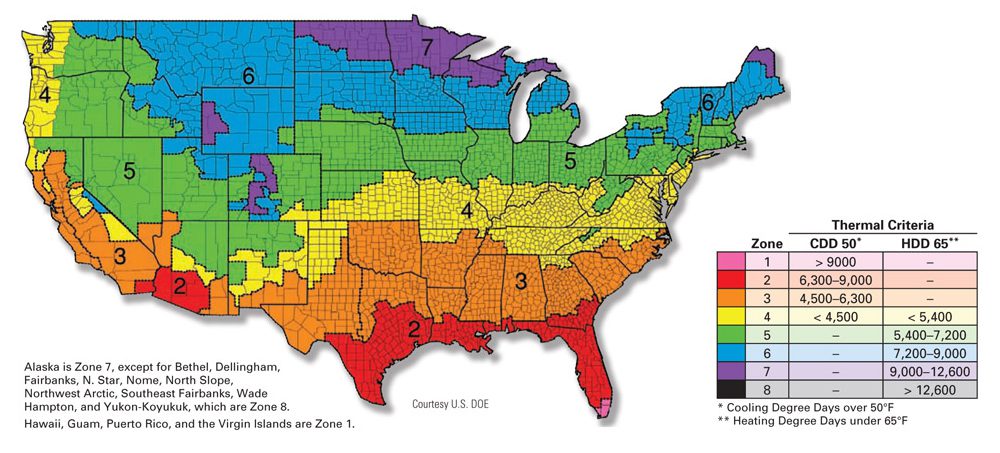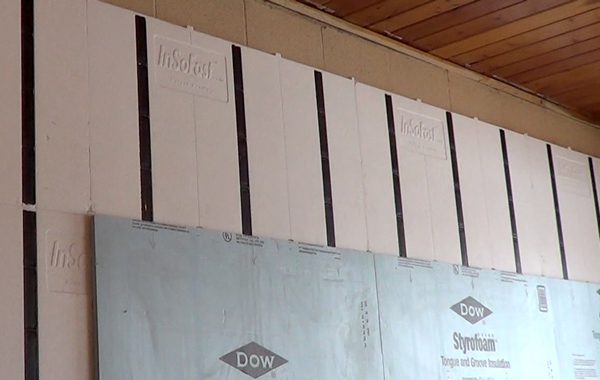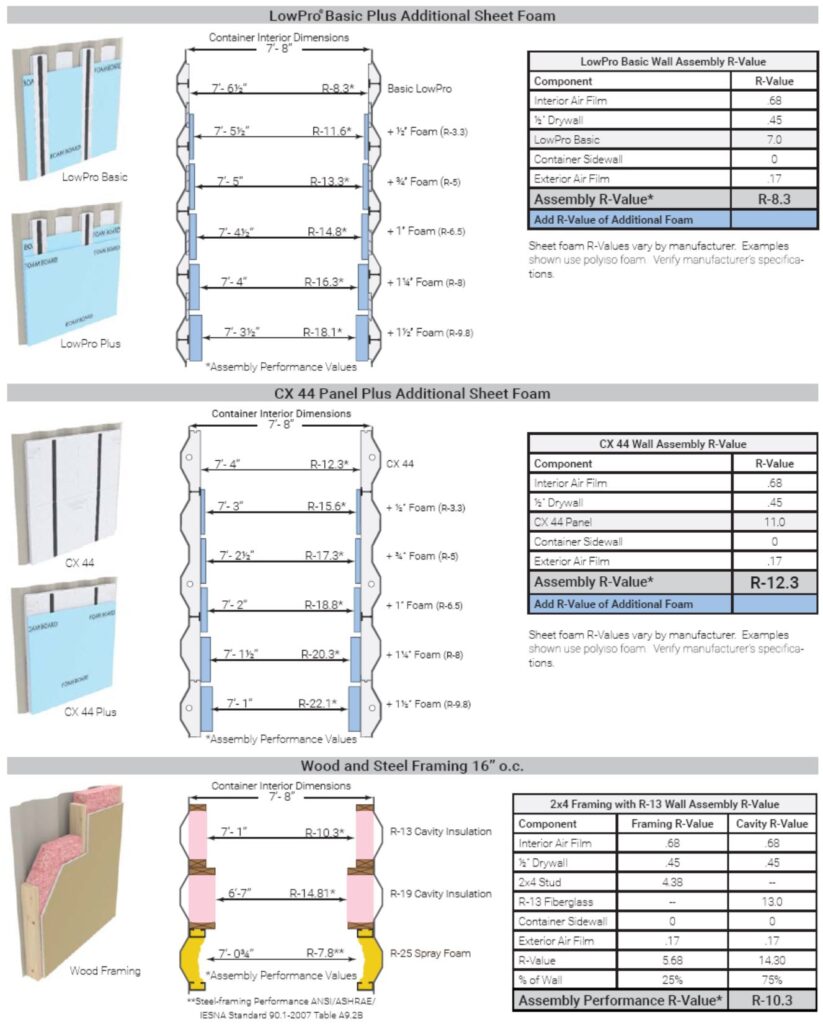How to Increase R-Value
InSoFast Plus Method
Need a higher R-value? It’s easy to increase your R-Value beyond R-10 while maintaining the engineered benefits of the continuous InSoFast panels. Simply layer rigid foam insulation board over top of InSoFast panels, InSoFast PLUS. This saves money by utilizing locally obtained rigid foam to enhance the R-Value. Additionally, projects can be completed in a fraction of the amount of time because they start with a base of feature-rich, low-labor InSoFast panels.
In cavity insulation systems, traditional stud framing can account for at least 25% of wall space. When the studs are uninsulated, there is enough thermal bridging to drop the R-Value from 19 to 12.5 – nearly a 35% loss, which can render any additional layers of insulation useless.
Building codes have higher requirements for cavity insulation to make up for the uninsulated studs or framing members. That is why basement wall code reads 10/13 in many climate zones. It can be R-10 continuous insulated sheathing on the interior or exterior of the home or R-13 cavity insulation along the interior of the basement wall.
InSoFast Plus Method
Need a higher R-value? It’s easy to increase your R-Value beyond R-10 while maintaining the engineered benefits of the continuous InSoFast panels. Simply layer rigid foam insulation board over top of InSoFast panels, InSoFast PLUS. This saves money by utilizing locally obtained rigid foam to enhance the R-Value. Additionally, projects can be completed in a fraction of the amount of time because they start with a base of feature-rich, low-labor InSoFast panels.
How do I find my code requirements?
Start with determining your climate zone. Next click this hyperlink R-Value Code Requirements for the national code guide line.

Added R-Value with InSoFast PLUS
You can use any panel CX 44, UX 2.0, or EX 2.5 panels to develop an InSoFast PLUS wall for a complete R-Value wall assembly – giving you the ability to go from R-8.5 to R-21+.
| InSoFast PLUS assembled system** | UX 2.0 PLUS | (Complete assembly*) | EX 2.5 PLUS | (Complete assembly*) |
| InSoFast PLUS -½” Foam @ R-2.5 | R-11 | (R-13.58) | R-13 | (R-16.08) |
| InSoFast PLUS -¾” Foam @ R-3.75 | R-12.25 | (R-14.83) | R-14.25 | (R-16.83) |
| InSoFast PLUS -1″ Foam @ R-5.0 | R-13.5 | (R-16.08) | R-15.5 | (R-18.08) |
| InSoFast PLUS -1½” Foam @ R-7.5 | R-16 | (R-18.58) | R-18 | (R-20.58) |
| InSoFast PLUS -2″ Foam @ R-10 | R-18.5 | (R-21.08) | R-20.5 | (R-23.08) |
- Embedded studs provide a continuous insulation (CI) barrier, eliminating thermal bridging.
- Add any amount of rigid foam over the InSoFast base panels to achieve any desired R-Value.
- Solid attachment can be achieved simply with adhesives. If preferred, they can be drilled or nailed.
- Interlocking panels bridge over wall deviations to help level and plumb the wall.
- Ventilated air channels control over moisture that can enter exposed masonry to allow for quicker drying.
- Pre-engineered electrical raceways enable the insulation shield to stay complete and intact.
- This calculation assumes the following:
** This is only an approximation of the assumed total R-Values of the components of the wall and the selection of the PLUS insulation added together. Results will vary depending on the materials chosen.
(Complete assembly*) The R-value calculation added to the entire assembly
| (Components + R-Value ) | R-Value |
| Interior Air Film | .68 |
| 1/2″ Drywall | .45 |
| Plus Insulation | ? |
| Concrete | 1.28 |
| Exterior Air Film | .17 |
| Total Assembled R-Value | 2.58 |
Independent R-Value Calculator from Construction Instruction R-Value Calculator
Independent Condensation Calculator from Construction Instruction Condensation Calculator
Increasing R-Values For Shipping Containers

Three compliance paths towards energy efficiency:
R-19 walls with an R-38 Roof is beyond the needs for small air tight insulated container.
Building Codes (IRC, IBC, IFC…) are primarily prescriptive in nature, the energy codes are geared more towards performance and effectiveness. To address this difference Code writing bodies have created 3 means of complying with the newer energy codes:
- Prescriptive – you follow the code to the letter (no energy trade-offs – i.e. better windows thicker roof insulation doesn’t mean you can skimp somewhere else)
- Performance – insulation trade off option – i.e. architect uses ResCheck to show compliance (for example exterior continuous insulation in favor of adding more insulation for the roof.) InSoFast believes that with containers a balanced approach to all exterior surfaces. (i.e. refrigerator roof is not thicker than the walls.)
- The HERS Path- where one has to meet or be less than a target HERS score where you can use higher efficient appliances to comply (Only available in newer codes 2015 / 2018 )
Interior-Living-Area vs R-Value
InSoFast lets you balance high performance wall insulation against your valuable interior living space.
Download Chart as a PDF for code submittal. Shipping Container R-Value vs Space Comparison InSoFast
InSoFast PLUS in Action

At an award-winning project in North Dakota, the developer wanted additional insulation without sacrificing interior area. They chose InSoFast to be directly install onto the masonry wall with an additional 1″ rigid insulation board placed on top to increase the R-Value to meet the local energy code requirements. It was a labor-saver for this fast track retrofit project.

The InSoFast panels were installed first so the studs would be securely fastened to the concrete substrate. The 1″ rigid foam was installed over top with the InSoFast stud locations marked on the floor and ceiling prior to adding the drywall. To attach the drywall, they used all-purpose 2″ drywall screws to penetrate through the drywall and rigid foam into the InSoFast studs.
Importance of Continuous Insulation
The American Society of Heating, Refrigerating and Air-Conditioning Engineers (ASHRAE) standard 90.1 defines continuous insulation (CI) as insulation that is continuous across all structural members without thermal bridges other than fasteners and service openings. It is installed on the interior, exterior, or is integral to any opaque surface of the building envelope.
In cavity insulation systems, traditional stud framing can account for at least 25% of wall area. When the studs are uninsulated, there is enough thermal bridging to drop the R-Value from 19 to 12.5 – nearly a 35% loss, which can render any additional layers of insulation useless.
Building codes have higher requirements for cavity insulation to make up for the uninsulated studs or framing members. That is why basement wall code reads 10/13 in many climate zones. It can be R-10 continuous insulated sheathing on the interior or exterior of the home or R-13 cavity insulation along the interior of the basement wall.
Changing Energy Codes
New building codes are increasing R-Values minimums every 3-5 years so that new houses are will not be obsolete or un-affordable 30 years from now due to escalating energy prices. The projected codes for 2030 demand R-Values up to R-30 and the push toward net-zero housing is becoming a reality. While these codes are well-intentioned, they don’t always figure a return on investment into the calculation.
To prepare for rising costs and changing energy environments, you may need to exceed your current local energy codes. See the links at the bottom of this page for information on Climate Zones and changes to the International Energy Conservation Codes (IECC).
Related Information
- InSoFast Panel R-Value Report, Stork Twin City Testing
- InSoFast R-Value vs Space Comparison for Shipping Containers
- Safe Use Compliance of Shipping Containers Download
- Find your local State R-Value Code Requirements
- The NYSERDA Energy Code Program
- Chapter 4 Section 402 Building Thermal Envelope 2015 IECC requirements
- Chapter 4 Section 402 Building Thermal Envelope 2018 IECC requirements
- Musings of an Energy Nerd: An Overview of the 2012 Energy Code (Green Building Advisor Blog)
- Building Science Corporation: A Bridge too Far (PDF, 1.16Mb)
- An InSoFast PLUS Project receives the ABC’s Award for Excellence in Construction
- BSD-163: Controlling Cold-Weather Condensation Using Insulation
- Moisture-Control-in-Buildings-moisture-control-8.pdf
- Temperature Dependence of R-values




